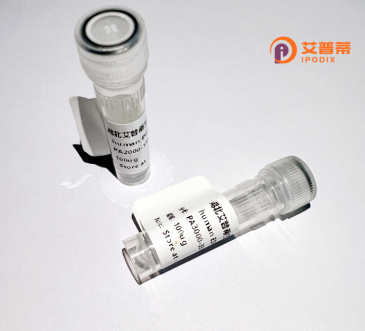
| 纯度 | >90%SDS-PAGE. |
| 种属 | Human |
| 靶点 | LASS1 |
| Uniprot No | P27544 |
| 内毒素 | < 0.01EU/μg |
| 表达宿主 | E.coli |
| 表达区间 | 1-239aa |
| 活性数据 | MPESAWKFLFYLGSWSYSAYLLFGTDYPFFHDPPSVFYDWTPGMAVPRDIAAAYLLQGSFYGHSIYATLYMDTWRKDSVVMLLHHVVTLILIVSSYAFRYHNVGILVLFLHDISDVQLEFTKLNIYFKSRGGSYHRLHALAADLGCLSFGFSWFWFRLYWFPLKVLYATSHCSLRTVPDIPFYFFFNALLLLLTLMNLYWFLYIVAFAAKVLTGQVHELKDLREYDTAEAQSLKPSKAE |
| 分子量 | 54.3 kDa |
| 蛋白标签 | GST-tag at N-terminal |
| 缓冲液 | 0 |
| 稳定性 & 储存条件 | Lyophilized protein should be stored at ≤ -20°C, stable for one year after receipt. Reconstituted protein solution can be stored at 2-8°C for 2-7 days. Aliquots of reconstituted samples are stable at ≤ -20°C for 3 months. |
| 复溶 | Always centrifuge tubes before opening.Do not mix by vortex or pipetting. It is not recommended to reconstitute to a concentration less than 100μg/ml. Dissolve the lyophilized protein in distilled water. Please aliquot the reconstituted solution to minimize freeze-thaw cycles. |
以下为3篇涉及重组人LASS1(CERS1)蛋白的核心文献概要:
1. **《CERS1 regulates tumor cell proliferation and senescence through ceramide synthase activity》**
- 作者:Xu, R. et al.
- 摘要:研究揭示了LASS1/CERS1通过其神经酰胺合成酶活性调控肿瘤细胞增殖和衰老,重组蛋白实验证实其过表达可诱导癌细胞周期阻滞并抑制肿瘤生长。
2. **《LASS1 enhances chemosensitivity to cisplatin through ceramide-mediated apoptosis in ovarian cancer》**
- 作者:Chen, L. et al.
- 摘要:利用重组LASS1蛋白证明其通过合成C18-神经酰胺增强卵巢癌细胞对顺铂的敏感性,激活线粒体凋亡通路并抑制Bcl-2抗凋亡蛋白。
3. **《Structural and functional characterization of human ceramide synthase 1 (CERS1)》****
- 作者:Koybasi, S. et al.
- 摘要:首次报道重组人CERS1蛋白的体外酶活性分析,阐明其底物特异性及pH依赖性,为神经酰胺代谢相关疾病的药物开发提供结构基础。
注:若需具体DOI或补充领域文献,可进一步说明调整。
Recombinant human LASS1 (LAG1 longevity assurance homolog 1) protein is a key enzyme in sphingolipid metabolism, primarily involved in the biosynthesis of ceramides. Also known as ceramide synthase 1 (CerS1), it catalyzes the formation of dihydroceramide by conjugating sphinganine with specific fatty acyl-CoA substrates. LASS1 belongs to the LASS/CerS family, which comprises six isoforms (CerS1–6) with distinct substrate specificities and tissue expression patterns. Unlike other isoforms, CerS1 exhibits a strong preference for C18 fatty acyl chains, producing C18-ceramides that play roles in cellular processes such as apoptosis, autophagy, and cell cycle regulation. Dysregulation of LASS1 activity has been linked to neurodegenerative disorders, cancer, and metabolic diseases, highlighting its physiological and pathological significance. The recombinant form of LASS1 is typically produced in heterologous expression systems (e.g., E. coli or mammalian cells) to enable functional studies, structural analysis, and drug screening. Its availability facilitates research into ceramide-mediated signaling pathways and therapeutic targeting. Studies using recombinant LASS1 have elucidated its membrane-bound topology, catalytic residues, and regulatory mechanisms, providing insights into sphingolipid homeostasis and disease mechanisms. Researchers utilize this protein to explore its potential as a biomarker or therapeutic target in conditions associated with ceramide imbalance.
×